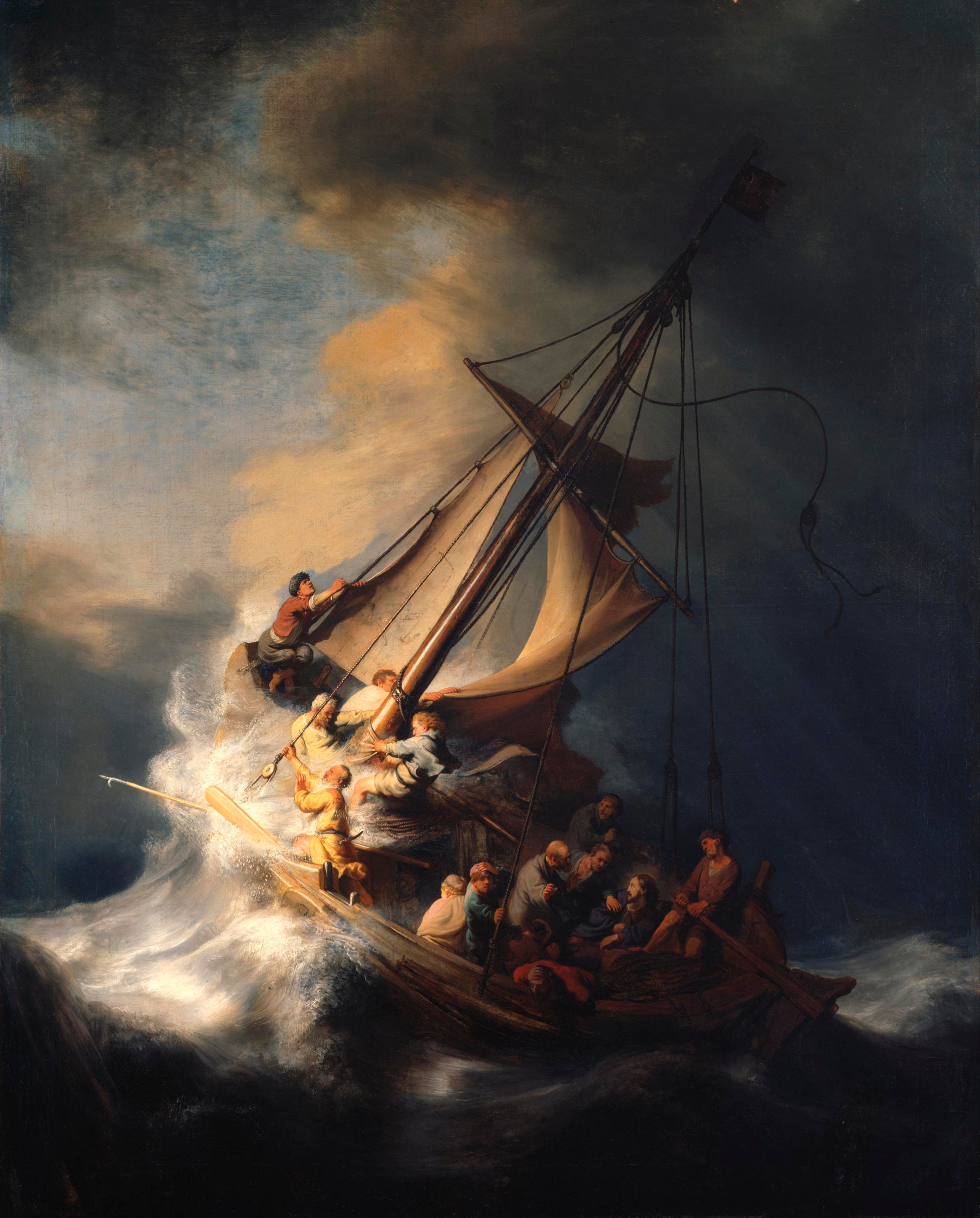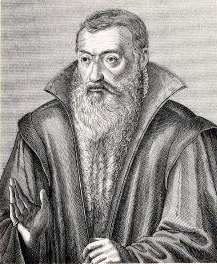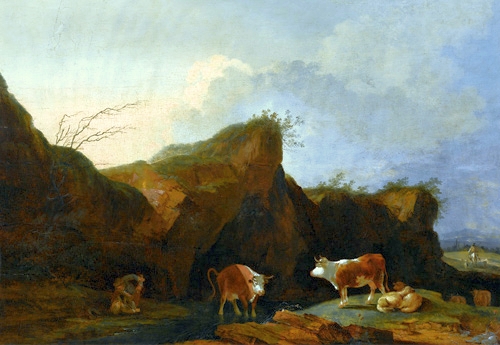|
Philippe Jacques De Loutherbourg
Philip James de Loutherbourg, RA (born Philippe Jacques de Loutherbourg; 31 October 174011 March 1812) was a French-born British painter who became known for his large naval works, his elaborate set designs for London theatres, and his invention of a mechanical theatre called the " Eidophusikon". He also had an interest in faith-healing and the occult, and was a companion of the confidence-trickster Alessandro Cagliostro. Early life Loutherbourg was born in Strasbourg in 1740, the son of an expatriate Polish miniature painter. Intended for the Lutheran ministry, he was educated at the University of Strasbourg. Paris Rejecting a religious calling, Loutherbourg decided to become a painter, and in 1755 placed himself under Charles-André van Loo in Paris, and later under Francesco Giuseppe Casanova. His talent developed rapidly, and he became a figure in the fashionable society of the day. He first exhibited at the Salon of 1763 where his '' Landscape with Figures an ... [...More Info...] [...Related Items...] OR: [Wikipedia] [Google] [Baidu] |
Portrait Of Philip James De Loutherbourg
''Philip James de Loutherbourg'' is a portrait painting by the British artist Thomas Gainsborough of the French-born painter and set designer Philippe Jacques de Loutherbourg. Born in Strasbourg, Loutherbourg settled in London in 1770 and became noted for his set designs at the Theatre Royal, Drury Lane as well as his landscape paintings, produced in an early romanticism, romantic style. Gainsborough's portrait was displayed at the Royal Academy's Summer Exhibition of 1778 at Somerset House. It is today in the collection of Dulwich Picture Gallery in London, having been part of the Bourgeois Bequest in 1811. A later self-portrait by Loutherbourg it now in the National Portrait Gallery, London, National Portrait Gallery. References Bibliography * Hamilton, James. ''Gainsborough: A Portrait''. Hachette UK, 2017. * Murray, Christopher John. ''Encyclopedia of the Romantic Era, 1760-1850, Volume 2''. Taylor & Francis, 2004. * Rosenthal, Michael & Myrone, Martin. ''Thomas Gainsbo ... [...More Info...] [...Related Items...] OR: [Wikipedia] [Google] [Baidu] |
Marine Painting
Marine art or maritime art is a form of figurative art (that is, painting, drawing, printmaking and sculpture) that portrays or draws its main inspiration from the sea. Maritime painting is a genre that depicts ships and the sea—a genre particularly strong from the 17th to 19th centuries. In practice the term often covers art showing shipping on rivers and estuaries, beach scenes and all art showing boats, without any rigid distinction – for practical reasons subjects that can be drawn or painted from dry land in fact feature strongly in the genre."Grove": Cordingley, D., ''Marine art'' in Grove Art Online. Accessed April 2, 2010 Strictly speaking "maritime art" should always include some element of human seafaring, whereas "marine art" would also include pure seascapes with no human element, though this distinction may not be observed in practice. Ships and boats have been included in art from almost the earliest times, but marine art only began to become a distinct genr ... [...More Info...] [...Related Items...] OR: [Wikipedia] [Google] [Baidu] |
Landscape With Figures And Animals
''Landscape with Figures and Animals'' is an oil on canvas landscape painting by the French artist Philip James de Loutherbourg, from 1763. It was the first painting the young Alsatian artist publicly exhibited. He submitted it to the Salon of 1763 at the Louvre in Paris where the art critic Denis Diderot's praise of it helped launch his career. Today it is in the collection of the Walker Art Gallery in Liverpool Liverpool is a port City status in the United Kingdom, city and metropolitan borough in Merseyside, England. It is situated on the eastern side of the River Mersey, Mersey Estuary, near the Irish Sea, north-west of London. With a population ....Wright, Gordon & Smith p.535 Loutherbourg subsequently emigrated to London where he became a pioneering painter of the emerging romantic movement. References Bibliography * Monks, Sarah, Barrell, John & Hallett, Mark (ed.) ''Living with the Royal Academy: Artistic Ideals and Experiences in England, 1768-1848''. Ashgat ... [...More Info...] [...Related Items...] OR: [Wikipedia] [Google] [Baidu] |
Salon Of 1763
The Salon of 1763 was an art exhibition held at the Louvre in Paris. It was held during the Ancien Régime era and was overseen by the Académie royale de peinture et de sculpture, Académie Royale. Staged during the reign of Louis XV it took place the same years as the Treaty of Paris (1763), Treaty of Paris ended the Seven Years' War. Many of the works featured were Rococo in style. Nonetheless ''The Cupid Seller'' by Joseph-Marie Vien was an early example of the Neoclassicism that would displace rococo to become the dominant style of the later nineteenth century. Philip James de Loutherbourg, a young painter from Alsace, made his Salon debut with ''Landscape with Figures and Animals''. The praise it received from the critic Denis Diderot boosted his career. The marine painter Joseph Vernet displayed several view of La Rochelle as part of his Views of the Ports of France series. As he did in other Salons, Diderot strongly praised Vernet's works for their faithful attention to re ... [...More Info...] [...Related Items...] OR: [Wikipedia] [Google] [Baidu] |
University Of Strasbourg
The University of Strasbourg (, Unistra) is a public research university located in Strasbourg, France, with over 52,000 students and 3,300 researchers. Founded in the 16th century by Johannes Sturm, it was a center of intellectual life during the Age of Enlightenment. The old university was split into three separate entities in the 1970s before merging back together in 2009. Today, the University of Strasbourg comprises 35 academic faculties, schools, and institutes, as well as 71 research laboratories spread across six campuses, including the historic site in the Neustadt. Throughout its existence, Unistra alumni, faculty, or researchers have included 18 Nobel laureates, two Fields Medalists and a wide range of notable individuals in their respective fields. Among them are Goethe, statesman Robert Schuman, historian Marc Bloch and several chemists such as Louis Pasteur. History The university emerged from the Jean Sturm Gymnasium, a gymnasium of Lutheran and humanist ins ... [...More Info...] [...Related Items...] OR: [Wikipedia] [Google] [Baidu] |
Lutheran
Lutheranism is a major branch of Protestantism that emerged under the work of Martin Luther, the 16th-century German friar and Protestant Reformers, reformer whose efforts to reform the theology and practices of the Catholic Church launched the Reformation in 1517. The Lutheran Churches adhere to the Bible and the Ecumenical Creeds, with Lutheran doctrine being explicated in the Book of Concord. Lutherans hold themselves to be in continuity with the apostolic church and affirm the writings of the Church Fathers and the first four ecumenical councils. The schism between Roman Catholicism and Lutheranism, which was formalized in the Diet of Worms, Edict of Worms of 1521, centered around two points: the proper source of s:Augsburg Confession#Article XXVIII: Of Ecclesiastical Power., authority in the church, often called the formal principle of the Reformation, and the doctrine of s:Augsburg Confession#Article IV: Of Justification., justification, the material principle of Luther ... [...More Info...] [...Related Items...] OR: [Wikipedia] [Google] [Baidu] |
Portrait Miniature
A portrait miniature is a miniature portrait painting from Renaissance art, usually executed in gouache, Watercolor painting, watercolor, or Vitreous enamel, enamel. Portrait miniatures developed out of the techniques of the miniatures in illuminated manuscripts, and were popular among 16th-century elites, mainly in England and France, and spread across the rest of Europe from the middle of the 18th century, remaining highly popular until the development of daguerreotypes and photography in the mid-19th century. They were usually intimate gifts given within the family, or by hopeful males in courtship, but some rulers, such as James I of England, gave large numbers as diplomatic or political gifts. They were especially likely to be painted when a family member was going to be absent for significant periods, whether a husband or son going to war or emigrating, or a daughter getting married. The first miniaturists used watercolour to paint on stretched vellum, or (especially in Engl ... [...More Info...] [...Related Items...] OR: [Wikipedia] [Google] [Baidu] |
Polish Diaspora
The Polish diaspora comprises Polish people, Poles and people of Polish heritage or origin who live outside Poland. The Polish diaspora is also known in modern Polish language, Polish as ''Polonia'', the name for Poland in Latin and many Romance languages. There are roughly 20,000,000 people of Polish ancestry living outside Poland, making the Polish diaspora one of the largest in the world and one of the most widely dispersed. Reasons for displacement include border shifts, forced expulsions, resettlement by voluntary and forced exile, and political or economic emigration. Substantial populations of Polish ancestry can be found in their native region of Central and Eastern Europe and many other European countries as well as in the Americas and Australia. The Polonia in English-speaking countries often uses a dialect of Polish called ''Poglish, Ponglish.'' It is made up of a Polish core with many English words inside it. There are also smaller Polish communities in Asia and Afric ... [...More Info...] [...Related Items...] OR: [Wikipedia] [Google] [Baidu] |
Loutherbourg Landscape With Cows
Philip James de Loutherbourg, RA (born Philippe Jacques de Loutherbourg; 31 October 174011 March 1812) was a French-born British painter who became known for his large naval works, his elaborate set designs for London theatres, and his invention of a mechanical theatre called the " Eidophusikon". He also had an interest in faith-healing and the occult, and was a companion of the confidence-trickster Alessandro Cagliostro. Early life Loutherbourg was born in Strasbourg in 1740, the son of an expatriate Polish miniature painter. Intended for the Lutheran ministry, he was educated at the University of Strasbourg. Paris Rejecting a religious calling, Loutherbourg decided to become a painter, and in 1755 placed himself under Charles-André van Loo in Paris, and later under Francesco Giuseppe Casanova. His talent developed rapidly, and he became a figure in the fashionable society of the day. He first exhibited at the Salon of 1763 where his ''Landscape with Figures and Ani ... [...More Info...] [...Related Items...] OR: [Wikipedia] [Google] [Baidu] |
Phillip James De Loutherbourg - The Battle Of Camperdown - Google Art Project
{{dab ...
Phillip may refer to: * Phillip (Bob the Builder), Bob the Builder's character * Phillip (character), Wallace & Gromit's character * Phillip (Saliba), Lebanese Orthodox prelate * Phillip (given name), given name * Phillip (surname), surname * Phillip, Australian Capital Territory, suburb of Canberra, Australia * Phillip Bay, suburb in the Eastern Suburbs of Sydney, Australia * Phillip County, one of the original Nineteen Counties in New South Wales See also * Phillip Island (other) * Phillips (other) * Philip (other) * Phillip Chancellor * Port Philip (other) Port Philip may refer to: * Port Philip, Nova Scotia See also *Port Phillip Port Phillip (Kulin languages, Kulin: ''Narm-Narm'') or Port Phillip Bay is a horsehead-shaped bay#Types, enclosed bay on the central coast of southern Victoria (Aus ... [...More Info...] [...Related Items...] OR: [Wikipedia] [Google] [Baidu] |
Alessandro Cagliostro
Giuseppe Balsamo (; 2 June 1743 – 26 August 1795), known by the alias Count Alessandro di Cagliostro ( , ), was an Italian occultist and confidence trickster. Cagliostro was an Italian adventurer and self-styled magician. He became a glamorous figure associated with the royal courts of Europe where he pursued various occult arts, including psychic healing, alchemy, and scrying. His reputation lingered for many decades after his death but continued to deteriorate, as he came to be regarded as a charlatan and impostor, this view fortified by the savage attack of Thomas Carlyle (1795–1881) in 1833, who pronounced him the "Quack of Quacks". Later works—such as that of W. R. H. Trowbridge (1866–1938) in his ''Cagliostro: the Splendour and Misery of a Master of Magic'' (1910), attempted a rehabilitation. Biography Origin The history of Cagliostro is shrouded in rumour, propaganda, and mysticism. Some effort was expended to ascertain his true identity when he was arreste ... [...More Info...] [...Related Items...] OR: [Wikipedia] [Google] [Baidu] |






